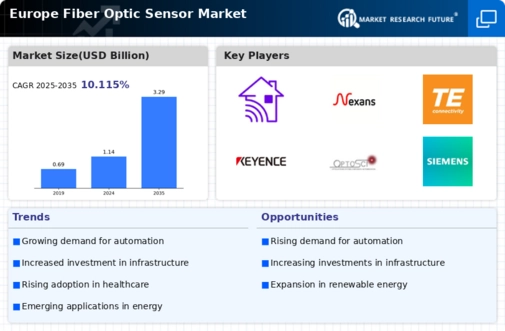The Europe Fiber Optic Sensor Market has witnessed significant growth in recent years, primarily driven by advancements in technology and the rising demand for precise and efficient sensing solutions across various industries. The competitive landscape of this market is characterized by the presence of both established players and emerging companies that are continuously innovating to provide cutting-edge products. Competitive insights indicate that companies in this sector are focusing on expanding their product portfolios, enhancing manufacturing capabilities, and forming strategic partnerships to capitalize on the growing demand for Fiber Optic Sensors.
With increasing investments in research and development, industry players are striving to improve reliability, accuracy, and performance, which has led to dynamic shifts in market share and competitiveness.Omni Fiber has established itself as a strong player in the European Fiber Optic Sensor Market, known for its innovative technology and high-quality product offerings. The company leverages its extensive expertise in fiber optics to deliver sensors that cater to various applications, including industrial monitoring, environmental sensing, and structural health monitoring. Omni Fiber's strengths lie in its robust research and development capabilities, allowing it to adapt quickly to evolving market demands.
The company's commitment to quality and performance has garnered a loyal customer base in Europe, where it has built a solid reputation. Through strategic marketing efforts and participation in industry conferences, Omni Fiber has managed to strengthen its market presence and expand its reach within the region.FISO Technologies is another key player in the Europe Fiber Optic Sensor Market. The company specializes in designing and manufacturing advanced fiber optic sensors and measurement systems that cater to a diverse range of applications, such as temperature, pressure, and strain measurements.
FISO Technologies has established a strong market presence through its innovative product offerings and exceptional customer service, which contribute to its competitive edge. The company has also engaged in strategic partnerships and collaborations to enhance its technological capabilities and expand its product range. With a focus on research and development, FISO has introduced several key products tailored to meet the specific needs of the European market. Its strengths lie in its ability to deliver high-performance solutions yet affordable options for customers.
The company has also been active in pursuing mergers and acquisitions, which support its growth strategy and enhance its operational capabilities within the Europe region.




















Leave a Comment